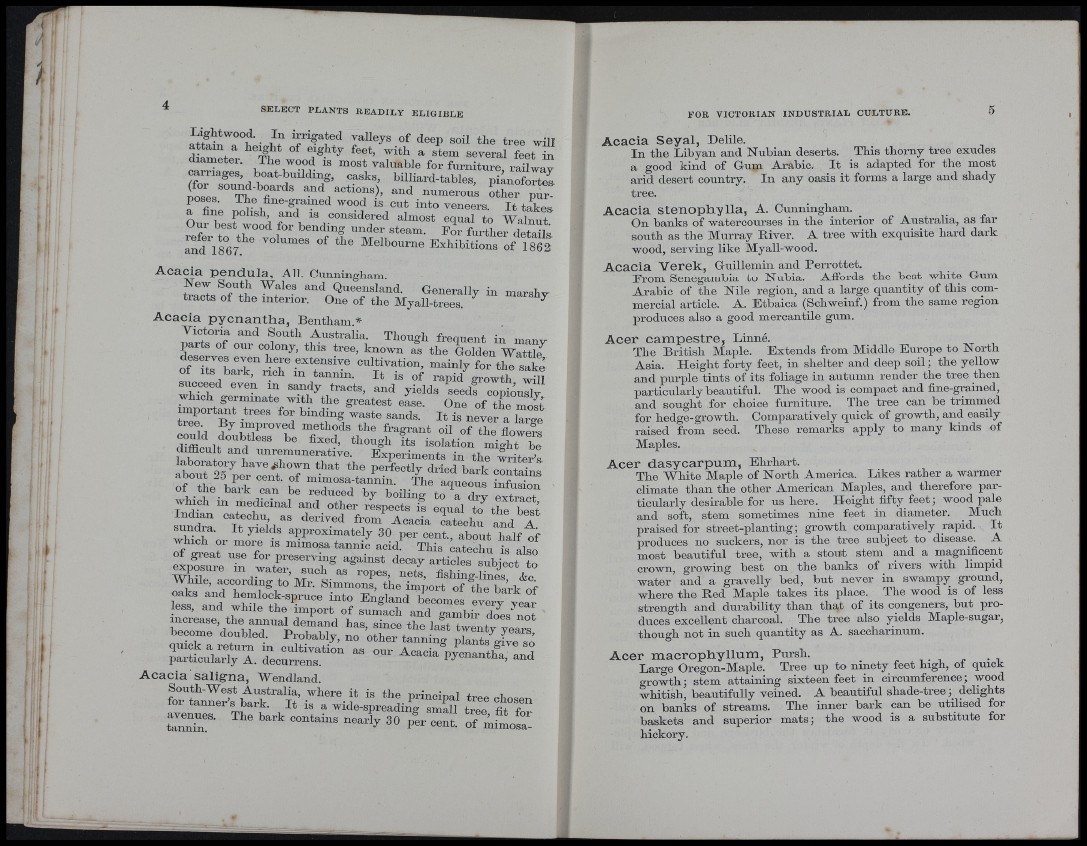
Lightwood. _ In irrigated valleys of deep soil tlie tree will
attain a lie^ lit of eighty feet, with a stem several feet in
diameter. The wood is most valuable for furniture railway
carnages, boat-buildmg, casks, billiard-tables, pimioforte»
f i o s ' ^ T h Ì r and aetions), and numerous other p ^
poses. The fine-grained wood is cut into veneers. I t takes
a fine polish and is considered almost equal to Walnut
Olir best wood for bending under steam. For further details.
a i r i 8 6 7 Melbourne Exhibitions of 1862
Acacia pendala, All. Cunningham.
New South Wales and Queensland. Generally in marshy
tiacts of the interior. One of the My all-trees.
Acacia pycnantha, Bentham.^
Victoria and South Australia. Though frequent in msnv
parts of our colony, this tree, known as the Golden Wattle
deserves even here extensive cultivation, mainly for the sake-
of Its bark, rich in tannin. I t is of rapid .rowth ^11
succeed even in sandy tracts, and yields seeds copimislv
which germinate with the greatest ease. One of the moS
importmit trees for binding waste sands. I t is never a large
T/i methods the fragrant oil of the flowers
isolation might be
difficult and nnremunerative. Experiments in the writer’s,
laboratory bave^hown that the perfectly dried bark contains
o M The aqueoi« S i
of the bai k can be reduced by boiling to a dry extract
which in medicmal and other respects is equal to the bett
Indian catechu as derived from Acacia catechu and A
^ approximately 30 per cent., about half of
hich 01 moi e is mimosa tannic acid. This catechu is also
exposure WL 1 Tinn wwatletif, ' ^suTch^ a s ropes, nets, fishinff-lines to
While, according to Mr. Simmons, the import of the bark of
D ak s and hemlock-spruce into England becomes e t r y ^
less, and while the import of sumach and gambir do^s^ot
increase, the annual demand has since tbp f
become doubled. Probably, „ 0 ^ 0^ ^ ^ ^ V S
Acacia saligna, Wendland.
South-West Australia, where it is the nrinpinf,!
for tanner’s bark. I t ’ is a wide-spreadV^“ 3 t e e t Z
30 p“er cent, m : W
Acacia Seyal, Delile.
In the Libyan and Nubian deserts. This thorny tree exudes
a good kind of Gum Arabic. I t is adapted for the most
arid desert country. In any oasis it forms a large and shady
tree.
Acacia S te n o pB y lla , A. Cunningham. _
On banks of watercourses in the interior of Australia, as far
south as the Murray Biver. A tree with exquisite bard dark
wood, serving like Myall-wood.
Acacia Verek, Guillemin and Perrottet.
From Senegambia to Nubia. Affords the best white Gum
Arabic of the Nile region, and a large quantity of this commercial
article. A. Etbaica (Schweinf.) from the same region
produces also a good mercantile gum.
Acer campestre, Linné.
The British Maple. Extends from Middle Europe to North
Asia. Height forty feet, in shelter and deep soil ; the yellow
and purple tints of its foliage in autumn render the tree then
particularly beautiful. The wood is compact and fine-grained,
and sought for choice furniture. The tree can be trimmed
for bedge-growtli. Comparatively quick of growth, and easily
raised from seed. These remarks apply to many kinds of
Maples.
Acer dasycarpum, Ebrbart.
The White Maple of North America. Likes rather a warmer
climate than the other American Maples, and therefore particularly
desirable for us here. Height fifty feet; wood pale
and soft, stem sometimes nine feet in diameter. Much
praised for street-planting; growth comparatively rapid. I t
produces no suckers, nor is the tree subject to disease. A
most beautiful tree, with a stout stem and a magnificent
crown, growing best on the banks of rivers with limpid
water and a gravelly bed, but never in swampy ground,
where the Bed Maple takes its place. _ The wood is of less
strength and durability than that of its congeners, but produces
excellent charcoal. The tree also yields Maple-sugar,
though not in such quantity as A. saccharinum.
Acer macropkyllum, Pursb. . , . , i- • i
Large Oregon-Maple. Tree up to ninety feet high, oi quick
growth; stem attaining sixteen feet in circumference; wood
whitish, beautifully veined. A beautiful sbade-tree;_ delights
on banks of streams. The inner bark can be utilised for
baskets and superior mats; the wood is a substitute for
hickory.